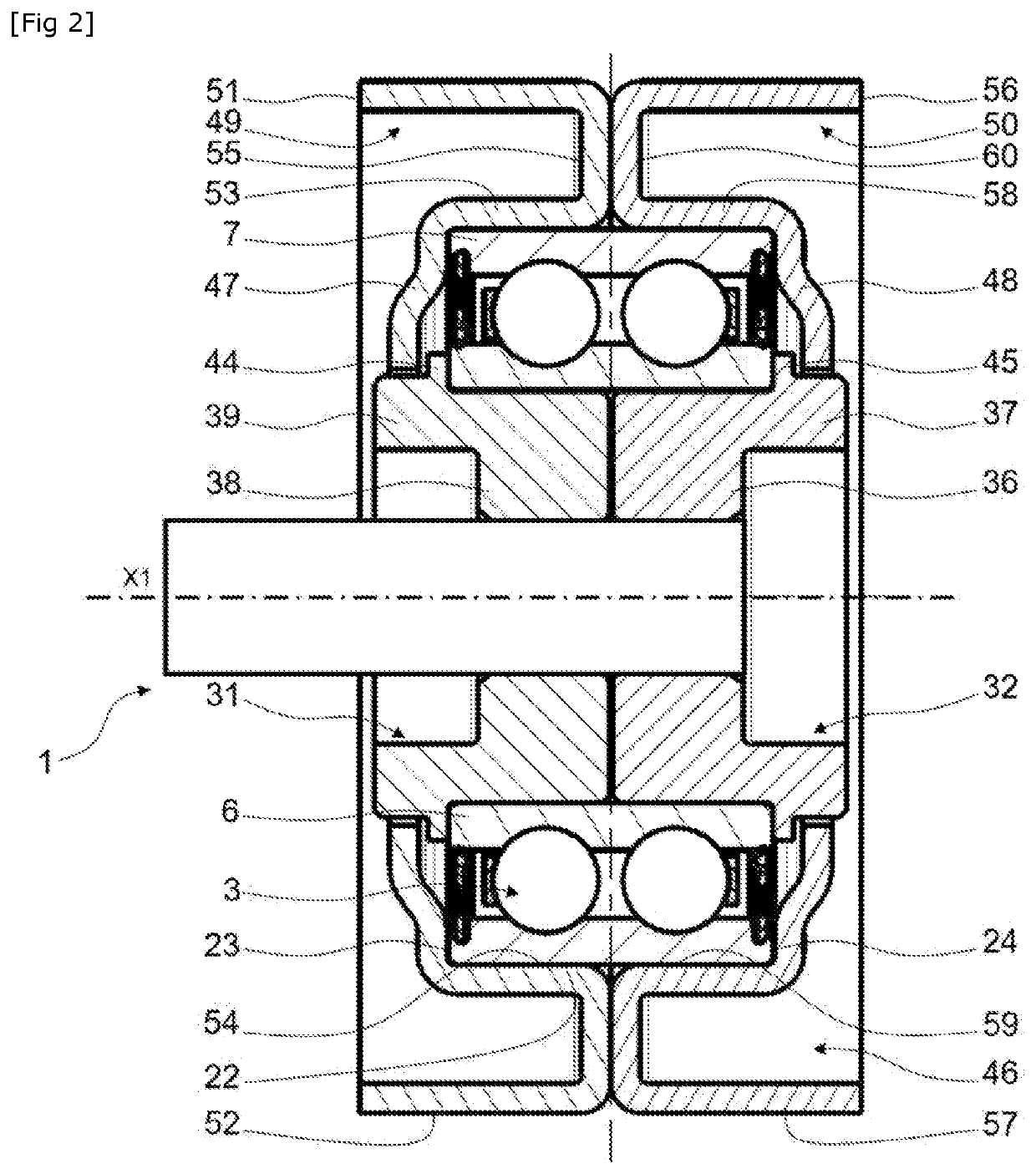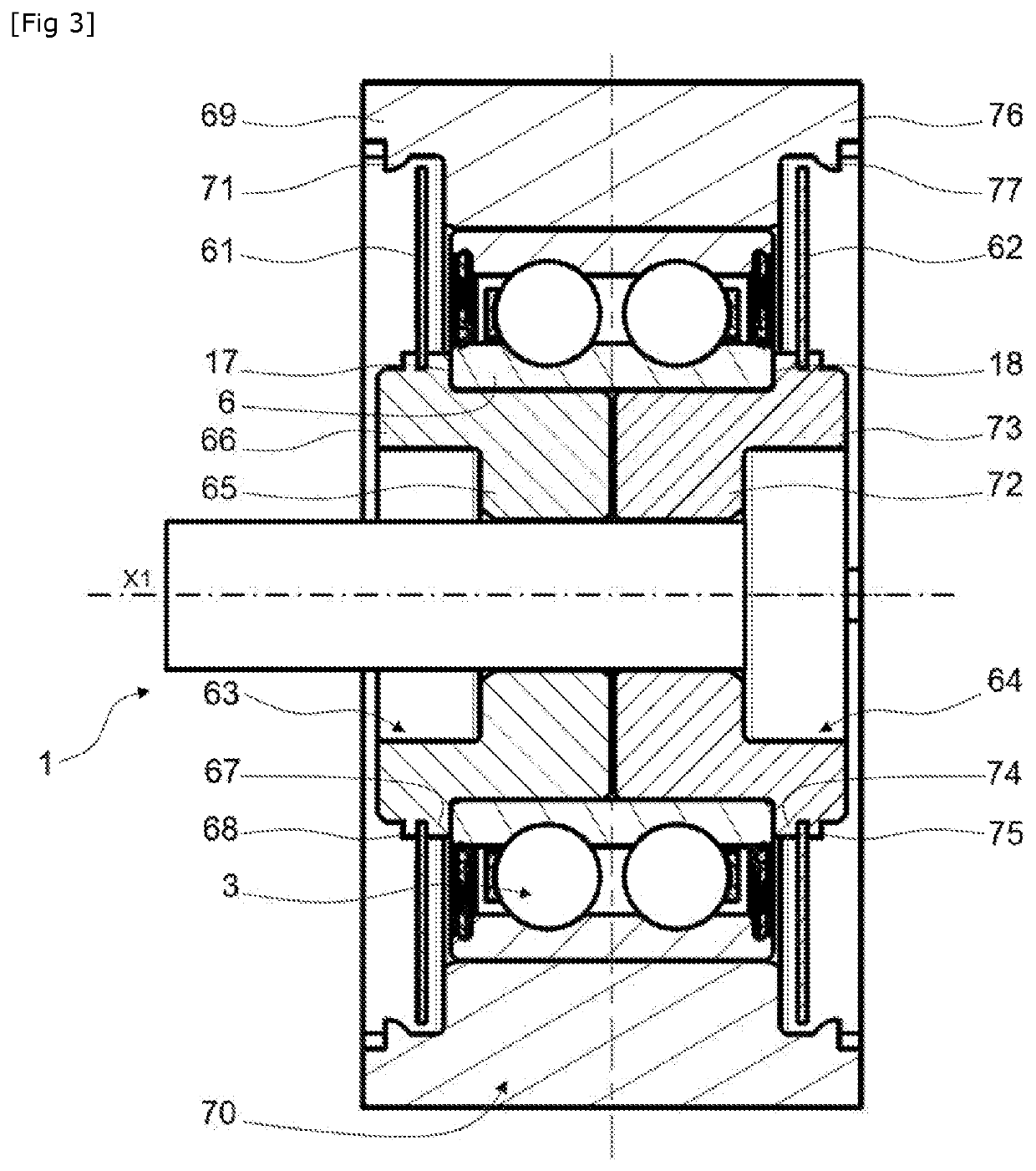Pulley Device
a pulley and device technology, applied in the direction of bearing unit rigid support, hoisting equipment, gearing, etc., can solve the problems of accelerated deterioration of internal components of bearings, and increased risk of pollution penetrating into bearing chambers with the duration of use of the pulley devi
- Summary
- Abstract
- Description
- Claims
- Application Information
AI Technical Summary
Benefits of technology
Problems solved by technology
Method used
Image
Examples
first embodiment
[0066]According to the invention first embodiment illustrated in FIG. 1, the outer first ends of the rear 4 and front 5 shields are rigidly connected to the pulley 2. In the example illustrated in FIG. 1, the outer first end of the front shield 5 rests axially against a collar 40 of the stepped and projecting front portion 30 of the pulley 2, and is held axially in the other direction by crimping portions 41 obtained via plastic deformations of the lateral edge of the portion 30. Similarly, the outer first end of the rear shield 4 rests axially against a collar 42 of the stepped and projecting rear portion 29 of the pulley 2, and is held axially in the other direction by crimping portions 43 obtained by plastic deformations of the lateral edge of the portion 29. Advantageously, crimping portions are circumferentially regularly distributed over the axially projecting rear 29 and front 30 portions of the pulley 2. Alternatively, the shields can be rigidly connected to the axially proj...
second embodiment
[0068]A second embodiment is illustrated in FIG. 2. The pulley device 1 according to this alternative embodiment differs from the previous embodiment illustrated in FIG. 1 in that a pulley 46 and rear 47 and front 48 shields form a single-piece assembly.
[0069]More precisely, the pulley 46 comprises a rear pulley element 49, and a front pulley element 50.
[0070]The rear pulley element 49 comprises an outer annular portion 51 with an outer cylindrical surface 52 that can engage a transmission means, and a cylindrical bore (not referenced). The element 49 also comprises an inner annular portion 53 with a cylindrical bore 54 tightly mounted on the outer cylindrical surface 22 of the rotating outer ring 7 of the bearing 3, and an outer cylindrical surface (not referenced). The outer annular portion 51 is tubular and moreover has a greater diameter than the inner annular portion 53 which is also tubular, the outer annular portion 51 radially surrounding the inner annular portion 53. The ou...
third embodiment
[0083]A third embodiment is illustrated in FIG. 3. It differs from the two embodiments described previously in that the rear 61 and front 62 shields are rigidly connected to the rear 63 and front 64 sleeves, respectively.
[0084]More precisely, the rear sleeve 63 comprises a cylindrical body 65 housed in the inner ring 6, and an outer radial skirt 66 axially projecting rearward with respect to the rear lateral surface 17 of the inner ring 6 of the bearing 3. The skirt 66 comprises a radially projecting collar 67. An inner end of the rear shield 61 is held to axially bear against the collar 67 via crimping portions 68 obtained by plastic deformations of the lateral edge of the skirt 66. The rear shield 61 is thus rigidly connected to the rear sleeve 63. The rigid connection can be achieved by any other suitable means, for example by sticking.
[0085]The rear shield 61 extends mainly radially from the inner end rigidly connected to the rear sleeve 63 toward an outer end coming into immedi...
PUM
 Login to View More
Login to View More Abstract
Description
Claims
Application Information
 Login to View More
Login to View More - R&D
- Intellectual Property
- Life Sciences
- Materials
- Tech Scout
- Unparalleled Data Quality
- Higher Quality Content
- 60% Fewer Hallucinations
Browse by: Latest US Patents, China's latest patents, Technical Efficacy Thesaurus, Application Domain, Technology Topic, Popular Technical Reports.
© 2025 PatSnap. All rights reserved.Legal|Privacy policy|Modern Slavery Act Transparency Statement|Sitemap|About US| Contact US: help@patsnap.com



